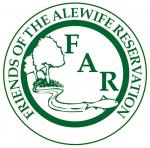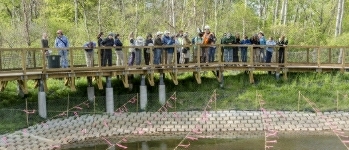by Ellen Mass
This review was published in the quarterly Growing Up in North Cambridge. The book is available for $10 at Porter Square Books.
No urban design plan anywhere deserves full implementation as much as the Alewife Reservation Master Plan of the MDC/DCR from 14 years ago, now 10 percent implemented with a 3 acres storm water wetland by an excellent team from former designer Wendi Goldsmith of Bioengineering of Salem financed by the state and city of Cambridge. Robert France, former Professor at Harvard graduate School of Design, now enriching Canada's Dalhousie University in Halifax with expanded disciplines in all aspects of ecological and hydrological sciences and landscape design. He documents the high environmental value of the coastal Alewife area in several books that include environmental activism , arts, cultural geography, France says Alewife Reservation is one of the largest green spaces in the watershed, and the last remnant of the Great Swamp from colonial times" , but recently clear cut this past October.
"Alewife watershed is one of historically most fascinating in country. Today it is often studied as the worst example of urban planning". France's books carry this theme with global examples, with warning: "Whenever a culture loses sight of their water sources and stops acknowledging their importance, long term problems occur. "Polluted rivers, paved-over wetlands, saline farmland, contaminated groundwater and overused aquifers are all caused by our disconnect from water as the source of life."
During Professor France's tenure, he expanded the content of environmental graduate classes, workshops and international conferences ( 50 presenters at HGSD from around the world in 2005) on watershed health, urban landscape design, climate protection, increasing the values for species biodiversity, spotlighting the Mystic River watershed and Alewife sub-watershed as a challenge for the muncipalities and state to take stringent conservation measures for its survival. In his book, "Facilitating Watershed Management", he models North American and a number of other-country's successful watershed projects from Canada, UAE, Arctic, Abu Dhabi and UK, etc. for guidance of local Alewife Harvard educational projects. While in Cambridge, he contributed to 150 publications and scientific papers, and many editorial contributions to international journals.
In 2004, "Alewife watershed" was the focus of 2 dozen projects for Harvard thesis requirements, professional development classes, and landscape design experiments, as he assumed his role with the state MDC as an Advisor to the Alewife Master Plan. His 700 page handbook of water design modeling expands the technical aspects of watershed management and presently read around the world.
As prolific author covering hydrology, urban and landscape design, and philosophy, his books also took on the arts, from understanding Henry D. Thoreau's nature message to spiritual healing and nature art performance presenting colleagues' writings to demonstrate holistic and integrative means for sustaining life with vital water corridors. In "Watershed Management", he dedicates the book "to watershed stewards for effective communication, empowered educational outreach and inspirational projects," knowing that passionate volunteers and caring community members need to steward the progress to sustain it. Watershed groups such as Friends of Alewife Reservation are cited for their outreach and ability to mobilize against abuses for watershed protection and for local educational tours. However, insufficient advocacy for conserving the floodplain land and preserving over 700 trees, will soon receive concrete covering as of a March 2015 with the granted town permit. In the international conference book "Handbook of Water Sensitive Ecological Planning and Design", a 500 page reference book, France wrote, "Urban wilds like A.R. are known for connecting city dwellers with nature." "The Reservation was once Native American seasonal fish camps, ice pond cutting and distribution throughout the world, and brick production from Alewife clay deposits (pits still exist with water and contamination). Last century was heavy industry, and finally in the 50's residential and commercial development.
However, the City is historically characterized as a university and literary center. Its agricultural and native Menotomy Indian history and its economic agricultural benefits from alewives harvesting, and vital floodplain remediator is equally noteworthy.
"Today, we need to look at Alewife, diseased with polluted water as a form of hemorrhaging." Hydrology is poor with low flow and rechanneled river and remains this way today." . Says France, in regards city and state needs for restoration of water flow: "There is no long term beneficial groundwater seeping into the wetlands during the summer droughts to maintain a base flow in Alewife Brook and Little River."
He highlights Vancouver researchers to explain, "We are displacing other species at the peril of our own survival because we cannot survive without biodiversity awareness. Aquatic diversity, has suffered the most." British Columbia, says France, recognizes that sustainability of their economy and communities depend on presence of sustainable environment. Many such environmental centers in US also confirm these goals. Ecologically sensitive designers and planners know this.
"Social Capital", defined by France, is about people and their worth. "Natural capital is sum total of ecological systems that support life and cannot be produced by humans who erode them". This capital is the foundation on which our "systems" exist, e.g. 80 percent of 1330 cultivated species for food requires wild pollinators. "As our green space dwindles and development continues with encroachments on waterways, societies opinions strengthen for preserving the few remaining precious and precarious spaces."
Alewife Brook/Little River or the "Upper Alewife Basin" of over 500 acres, encompasses 5 municipalities described by Scott Horsley (Horsley and Witten Inc.) which flows 3 miles between Cambridge and Arlington to the Mystic River. While there are expensive remediation efforts ongoing from 2013-15, the Basin was described by Robert France as "most floodprone and CSO combined sewer ridden river in eastern part of state.". Presently MWRA is expanding the sewer intercepter for Deer Island remediation at entry to the Reservation behind Alewife T stop to accommodate more development etc. This part of the "shed" requires regional planning, but France decries the state's jurisdiction limitations of "home rule" that supersedes regional planning and negates a 'common' watershed future despite a growing survival clamor from those low sea level neighborhoods which are built on the "shed" and increasingly subject to extreme flooding.
He discovered large numbers of private illegal encroachments at Alewife into public land, but as yet, little has been measured and returned to the public sphere.
Calling for conservation measures for Alewife, the author counts on inspiring "artistic literati" such as adoration from Henry D.Thoreau, James Joyce, Norman Maclean, Lo Pi, Annie Dillard for an intimate experience of "deep immersion" that transcends all boundaries for a restorative life and rebirth experience with nature." Professor France is enamored with 'water' that he says "defines us" and gives us life giving properties.
He delights in the giant Mystic River Watershed Association murals on Mystic Avenue defining the long and powerful history of the western Boston corridor, as does the creative 90 foot biodiversity mural produced by Friends of Alewife Reservation over the Alewife T stop, created after "Biodiversity Days" in 2002, an event sponsored by FAR, and inaugurated throughout Massachusetts by the famed Harvard author and biologist, E.O. Wilson, and Executive Office of Environmental Affairs Secretary, John Durand, creator of the Commonwealth "Biomaps". France foresaw MyRWA's annual herring run as a community watershed awareness event and lauded its potential.
He and students designed a cleansing watershed/wetland garden similar to the city 2013 storm water wetlands, now in place at Alewife, now touted by the state's environmental leaders as a New England highlight, with a state ceremony. Three marsh levels and tens of thousands of high variety wetland plants and wildflowers clean and filtrate the water from a dense neighborhood nearby which is being developed with 1700 units, and more coming, so that the storm water wetlands require careful monitoring and anti-pollution enforcement to be sustainable, not presently available.
Flora at Alewife includes bogs says France. "Bogs are essential to ecosystem for water regulation, humidity, ground water and climate."
Using the example of China's Cheungdu Park 50 miles of flood plain park or "living water garden". US landscapers, Betsy Damon creatively designed and built this large city watershed park with counterparts in Chengdu, capital of Sichuan Province with the Philadelphia landscape architect Margie Ruddick. It begin in 1996 and completed in 1998 with the Fu-Nan Rivers Restoration Bureau. The park design makes use of flow form shapes and cleans the river water, symbolizing a fish.
Chinese developed the theme: "keepers of the water", a system of many volunteers to maintain and steward by community groups with amphitheater and an environmental education center and spiritual connection to the waterways of China.
Professor France encourages watershed restoration projects at Alewife, "Restoring or constructing a wetland can be as aesthetic a process as building a garden or atrium." This is a small part of what is needed at Alewife Reservation to sustain a dense urban watershed with toxic material, bacterial and hydrological challenges.
- Home
- Directions
- FAR Wildlife Blog
- Calendar
- News
- Donate Now
- Get Social!
- Storm Water Wetlands
- Plants and Restoration
- Photos
- Videos
- About & Projects
- Master Plan for Alewife
- Archive
- Newsletters
- Contact
 Presentation Spotlighting Alewife Reservation
Presentation Spotlighting Alewife Reservation
 Follow us on Twitter
Follow us on Twitter
 Like us on Facebook
Like us on Facebook
 Follow us on Instagram
Follow us on Instagram
Forward our web address to a friend!
- An Urban Gem - Alewife Reservation Nature Preserve
- Envisioning The Silver Maple Forest
- History and Policies of Cambridge, Belmont, and DEP
- Storm Water Wetlands
- Friends of Alewife Reservation brochure
(front, back) - Technical Analysis of Upper Alewife Basin
- Watershed: An Excursion in Four Parts
- The River Is A Restless Spirit: Life in the floodplain forest
-
Assessment of Silver Maple forest for DEP Adjudicatory hearings and
Patrick Fairbairn, author of the Assessment - Community Native Garden Flora
The
Alewife Reservation
is a unique natural resource for the communities of Belmont, Arlington and Cambridge
and home to hundreds of species, including hawks, coyotes beavers, snapping turtles, wild turkeys and muskrats,
the reservation is a unique natural resource for the community.
Historical information (Powerpoint)
Friends of Alewife Reservation works to protect and restore this wild area and the surrounding area for the water quality, native plants, animals and over 90 bird species with paths for walking, running and biking, recreation, and for classroom education and research. We regularly steward and preserve the Reservation area for wildlife and for the enjoyment of present and future generations.

(video)
By-Laws
About Friends of Alewife Reservation
Statement of Purpose
Citizen Forester newsletter archive
The Birds of the Cambridge Region of Massachusetts

by William Brewster 1906
Nuttal Ornithological Society
Biodiversity Study of Alewife Reservation Area: Species, Habitat, Ecosystems

Inventories by David Brown, wildlife assessor (2003, 2004.) Published by and available from FAR for $10. Write or call for your copy. (sample)
Updated Dave Brown Inventories (2008, 2010)
Inventories of Alewife Reservation Wetland Plants by Walter Kittredge, Botanist (2013)

